SaaS pricing models: Everything you need to know
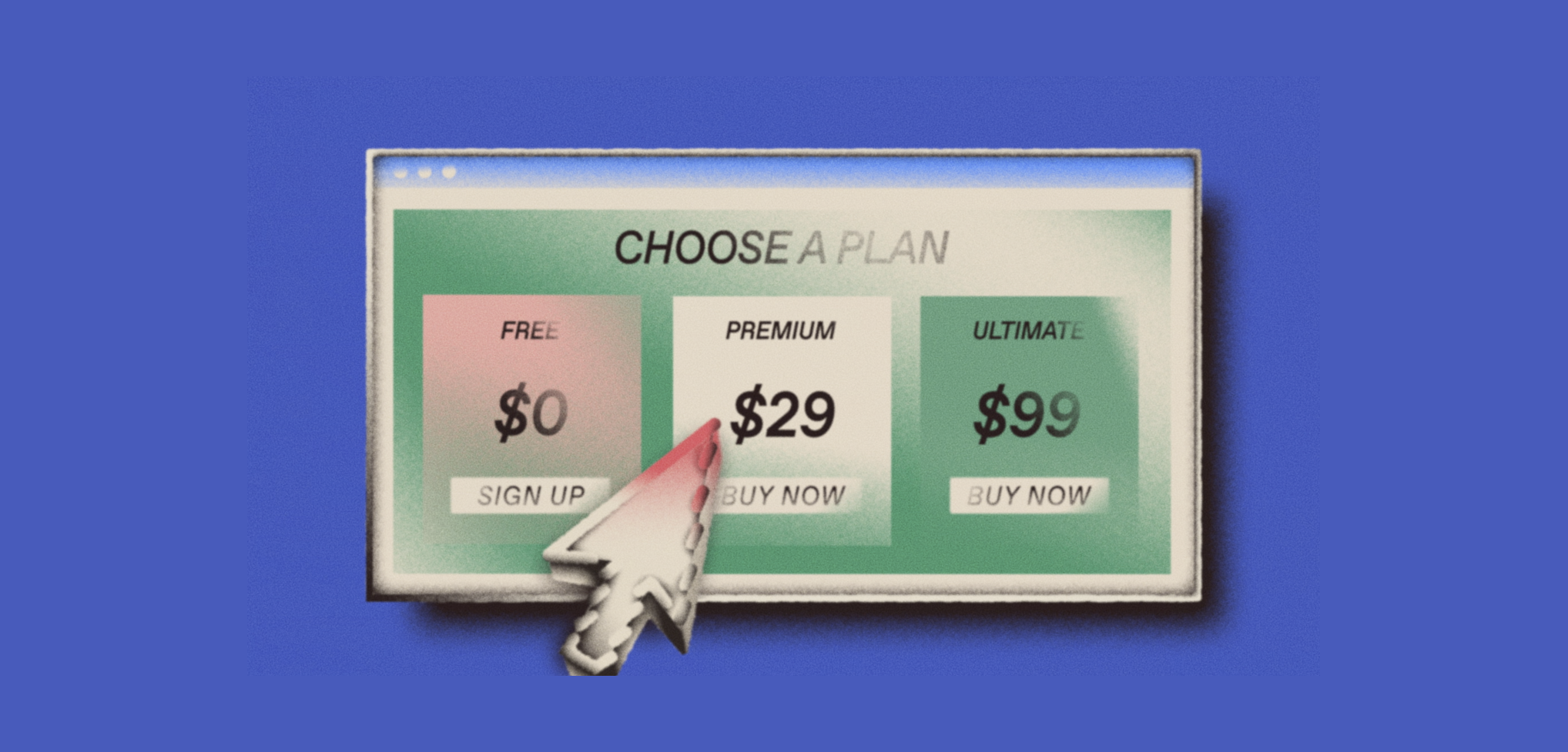
Getting the right SaaS pricing model is critical for driving revenue in your business. Pricing affects your bottom line even more than acquisition and retention.
In fact, a 1% improvement in how you monetize can lead to a 12.7% increase in profit.
That’s why defining your SaaS pricing model is one of the most important steps you can take for business success. And yet research has shown that companies spend a mere 6 hours on average defining it.
Why do so many SaaS companies still devote so little time to such a powerful growth lever? With so many SaaS pricing models to choose from, it could easily be a case of analysis paralysis.
In this article, we’ll cut through the noise and help you get clarity on the best SaaS pricing model for your business.
We’ll walk you through the most popular SaaS pricing models in detail, explore the key differences between a pricing model and pricing strategy, and discuss how to choose the right pricing model for your business – and how to know when it’s time to change things up.
The most popular SaaS pricing models
There are seven SaaS pricing models most commonly used:
- Flat-rate pricing
- Usage-based pricing
- Tiered pricing
- Per-user pricing
- Per active user pricing
- Per-feature pricing
- Freemium pricing
Let’s look at each one in turn.
Flat-rate pricing
What is flat-rate pricing?
This model is the simplest approach to selling SaaS. You offer one product at one price, with the same set of features – and that’s it. Customers get the choice between paying monthly or paying annually, often with a discount available for annual subscriptions.
Pros of flat-rate pricing
- Easy to communicate value – flat-rate pricing is easy for potential customers to understand. They don't need to struggle to decide which option. That also makes it more comfortable for you to sell.
- More focused – with just one product, you can focus all your sales and marketing efforts on it, and build clearly-defined funnels.
Cons of flat-rate pricing
- Limits customer diversity – for example, a product priced for enterprise buyers will likely be too expensive for small businesses. Finding the sweet spot for pricing can be tricky.
- Missing out on potential revenue streams – With just one price, it’s hard to up-sell when existing customers want more services
- Lack of nuance – potential customers either want it, or they don’t. You don't have much scope for persuading them.
Who is flat-rate pricing a good fit for?
Flat-rate pricing could work for your business if you offer either a simple product with a limited feature set, or a consumer-focused subscription product.
Flat-rate pricing in action
Project management software provider Basecamp offers a flat-rate pricing model targeting people working in teams online.
Basecamp charges a flat rate of $99 a month for 500 GB of storage, unlimited projects, unlimited users, and no per-user fees.

Usage-based pricing
What is usage-based pricing?
With this model, the cost of the product relates directly to how much a customer uses it. If they use more, the price goes up. If they use less, the price goes down.
Usage-based pricing is common among infrastructure software companies (like Amazon Web Services or Digital Ocean), which charge users based on things like the number of gigabytes of data they use, or how many API requests they make.
Pros of usage-based pricing
- Appeals to a wide range of customers with different needs
- A transparent financial model that gives the customer the responsibility for managing their usage
- Easier to attract new clients because the price is not the main deciding factor
Cons of usage-based pricing
- Unpredictable revenue – this model tends to attract customers with volatile use patterns, making it harder for you to predict and manage your revenue from one month to the next
- Growth depends on customers – your own growth is closely tied to that of your customers. You can only scale if their businesses grow, leading to them spending more money on your service
Who is usage-based pricing a good fit for?
It's great if your customers have volatile demand in their businesses, as you can tailor your pricing to match that demand.
This is especially attractive for smaller start-ups, as it gives them the option to use the same products as enterprise companies, at an affordable price point.
Usage-based pricing in action
Twilio is a cross-platform communication tool. It offers a choice of messaging in SMS, voice, video, WhatsApp, email, and more. Twilio offers users a small number of free credits to get started, then charges them by the number of messages they use.
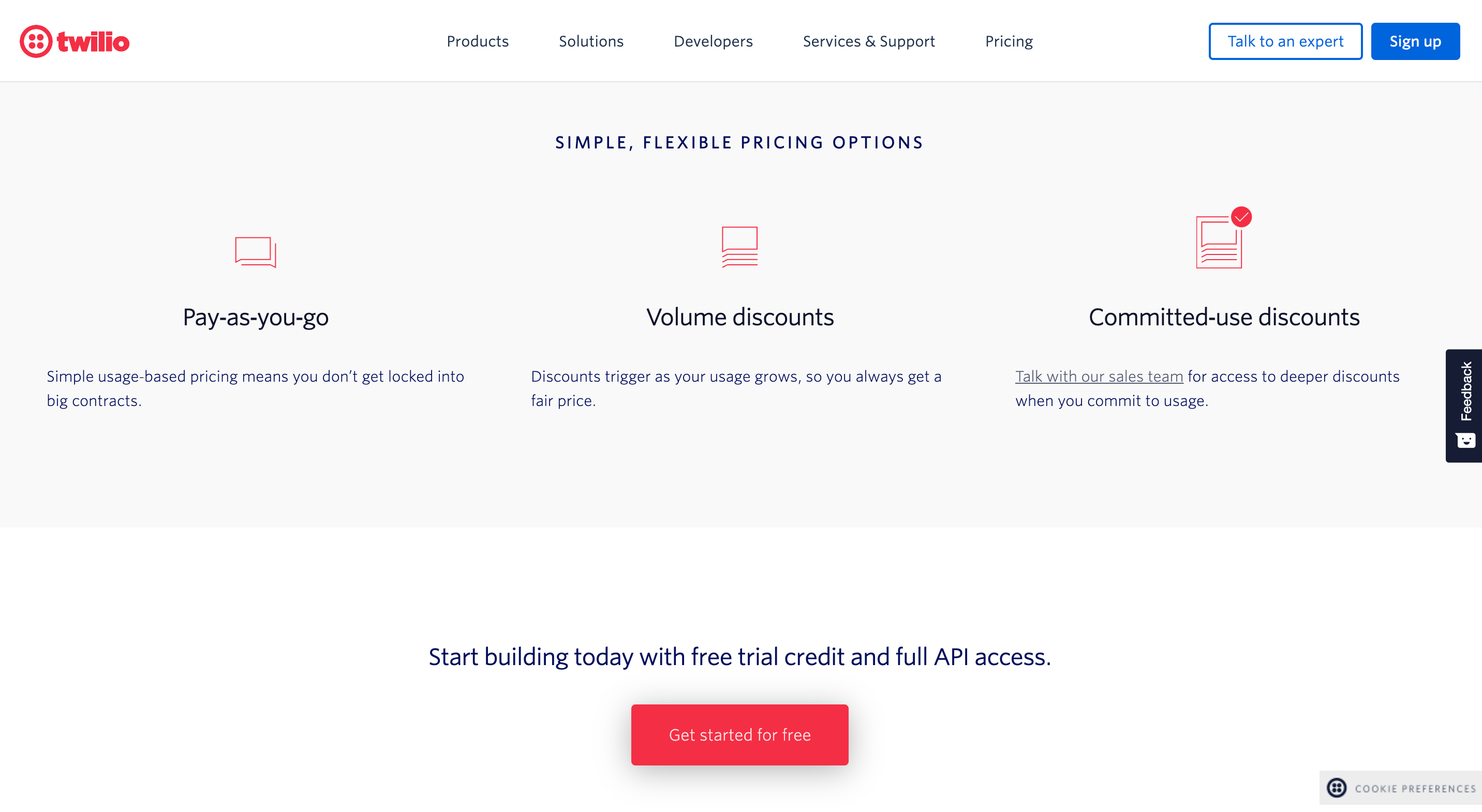
Tiered pricing
This is one of the most common models used in today's SaaS industry. Companies can offer several packages with tiered pricing, including different feature sets at different price points.
Many companies use three packages, at low, middle, and high price points. The lowest price point is typically designed to attract individuals and smaller startups, also opening up the opportunity to up-sell them into a higher tier later down the line.
Pros of tiered pricing
- Maximize your revenue – tiered pricing lets you tailor your offering to suit multiple types of customers
- Broader appeal – using multiple packages lets you appeal to a wider range of potential customers – individuals, small businesses, and enterprise clients – hence boosting your revenue potential
- Easy up-selling – the customer has an obvious route to the next level, once they outgrow their current tier. This helps boost your customer lifetime value and enhances customer loyalty.
Cons of tiered pricing
- Risk of overwhelm – too many options can confuse potential customers and lead to abandoned sales. It's usually best to stick with just three price tiers.
- Loss of focus – Creating too many packages with too many features can cause you to lose focus on your core target audience
- Deep audience research needed – this is key to make sure you combine the different features in the best way for the target audience. But it can consume a lot of time and effort.
Who is tiered pricing a good fit for?
If your business sells licenses, seats, or similar, then tiered pricing could be the best SaaS pricing model for you.
Tiered pricing in action
Zapier is a tool that helps users automate commonly repeated tasks. They use a pricing model structured around five tiers, ranging from ‘Free’ (zero cost) at the bottom to ‘Company’ (599 USD per month) at the top.
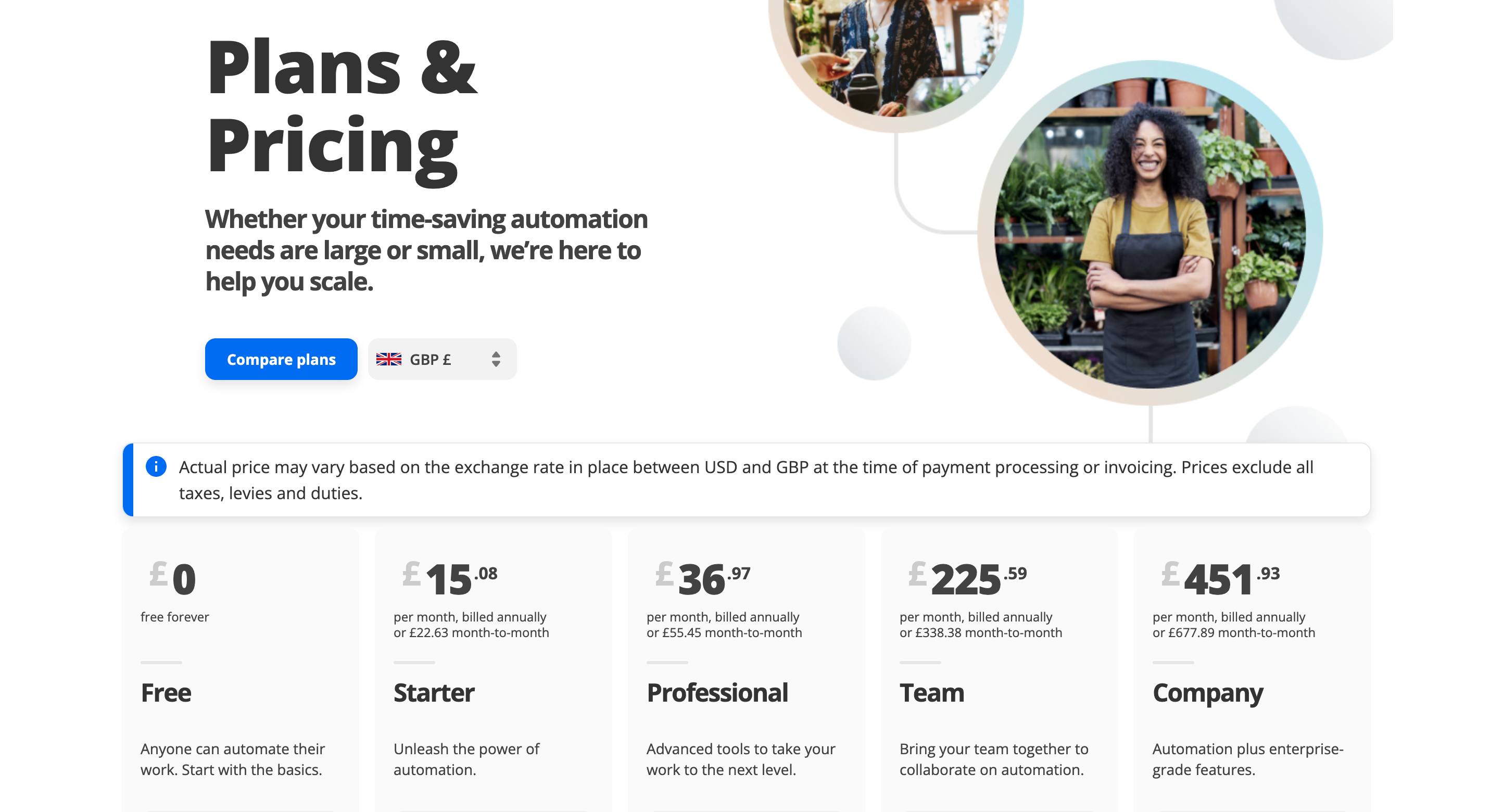
Per-user pricing
What is per-user pricing?
Per-user pricing is another one of the most popular pricing models currently used in the SaaS industry. It's popular because of its simplicity – a fixed monthly price for one user, double that price for a second user, and triple for a third.
Your customers can easily understand what they get for their money, and your SaaS company benefits from having predictable monthly revenue.
Pros of per-user pricing
- Simplicity – both for your customers and for your business
- Predictable revenue – with per-user pricing, you can easily forecast your revenue for each month
- Adoption is rewarded – your revenue is directly tied to user adoption, so increase your users and you'll also increase your revenue.
Cons of per-user pricing
- Users may cheat – per user pricing allows users to share logins with others, which means you lose out on additional revenue
- Limits number of users per organization – in order to save money on additional users, companies who buy your product will be careful how many licenses they buy
- Hard to communicate value – with per-user pricing, it’s harder for customers to see real value in adding another user
Who is per-user pricing a good fit for?
It's great for SaaS companies who rely heavily on a recurring revenue model because per-user pricing makes it really easy to predict your MRR.
Per-user pricing in action
The online graphic design tool Canva offers a per-user option among its other pricing options. For $30 per user per month, this includes all features from the Pro model, with access for every user on a team.
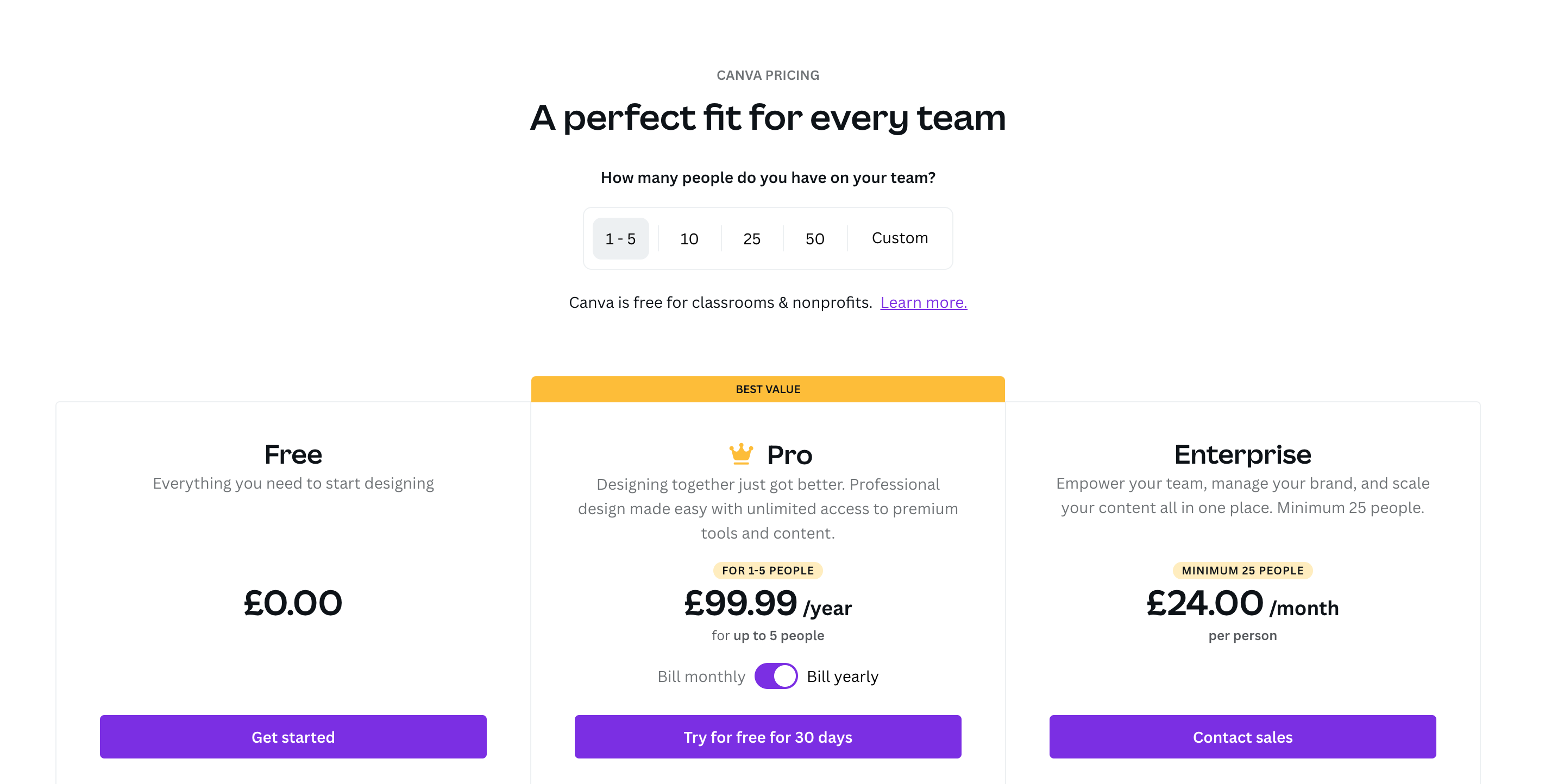
Per-active-user pricing
What is per-active-user pricing?
This is where you charge customers based on how active they are. It doesn't matter how many users are enrolled, you’ll only charge the customer based on the ones who actually use your product. Typically, this means charging for users who have logged in during the last 30 days.
Pros of the per-active-user model
- Customers don't have to waste money on inactive users.
- Easier decision for enterprise companies to roll out your product company-wide – as they only pay if it works.
Cons of the per-active-user model
- Bad fit for small businesses as it doesn't give much incentive when teams are small.
- Can be more complicated when compared to per-user pricing – especially in how to define ‘active user’
- It doesn’t fit well with annual price plans, as customers can perceive it as wasteful if the service does not get much use.
Who is per-active-user pricing a good fit for?
If you’ve had problems convincing customers to onboard with your per-user model, then a shift to the less risky per-active user pricing model could spur them to take the leap.
Per-active-user pricing in action
Cloud-based messaging platform Slack is a well-known example of a SaaS company succeeding with the per-active-user pricing model.

Per-feature pricing
What is per-feature pricing
Users aren't the only variable used to determine SaaS pricing models. As the name suggests, the per feature pricing model uses features to determine price.
Typically, this involves creating different packages and listing all the features contained in each one. Customers pay more when they need more features.
Common package names could be Standard, Pro, Advanced, or similar.
Pros of per-feature pricing
- Provides a strong incentive for customers to upgrade to the next level, in order to access more features
- Allows you to deliver high resource features as part of your top tier packages
Cons of per-feature pricing
- More potential for dissatisfied customers, because they're missing out on some functionality despite paying the fee
- Can be challenging to decide which features to include in each package – needs detailed research to know what each type of customer wants
Who is per-feature pricing a good fit for?
Per feature pricing is a versatile model. But it works best for SaaS businesses that have taken the time to clearly map each set of features to a specific customer persona. If all your features are a great fit for all customers, you’ll lose out on the benefits of the per feature pricing model.
Per-feature pricing in action
Note-taking tool Evernote offers Basic, Plus, and Premium plans, with different features unlocked at each level.
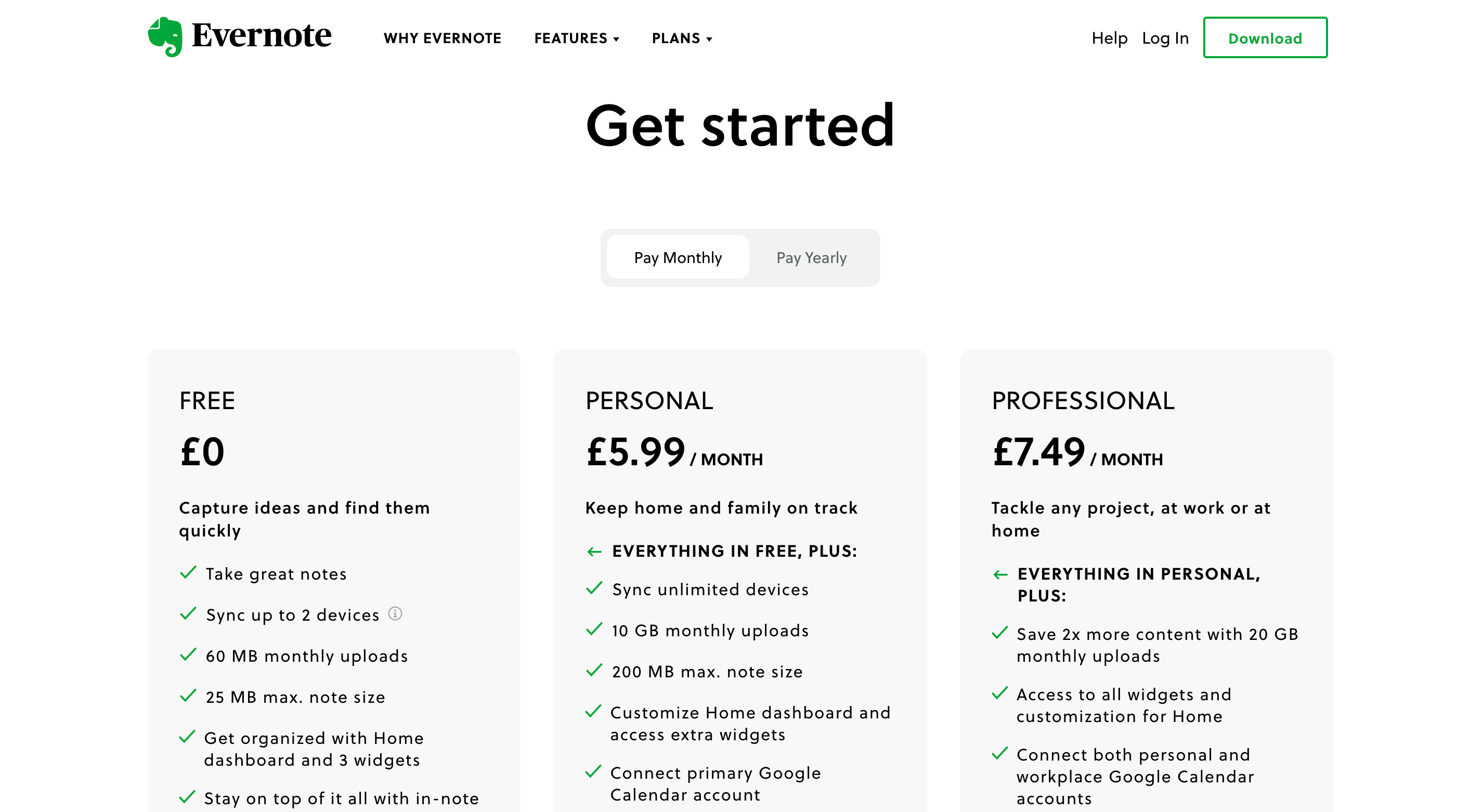
Freemium pricing
What is freemium pricing?
This one is normally used as a gateway to additional paid packages. The freemium tier represents the entry-level, with users regularly incentivized to upgrade to a paid tier.
For example, you might have a pop-up box when they try to use a feature that's not available in the freemium tier. Evernote uses this approach.
The free tier usually has limitations on features, capacity, or types of use cases.
Pros of the freemium pricing model
- Reduced barrier to adoption – users love to try a new service without having to first enter their credit card details.
- Build a large customer database – freemium users can be a great source of emails for your list, to help you build relationships with them going forward
- Great way to test new features on different customer personas
Cons of the freemium pricing model
- Risk of resource drain – constantly serving freemium users can be an unnecessary drain on your resources, with no revenue to show for it.
- Difficult to establish value – people love getting free things and may sometimes prefer to stick to freemium forever.
Who is the freemium pricing model a good fit for?
It's great for new SaaS businesses that need to raise awareness of their product. An excellent free tool can quickly go viral on social media, leading to widespread buzz and more chances of paid signups.
Freemium pricing in action
MailChimp is a popular email marketing platform with a generous freemium offering. Users can get started easily, with enough free functionality to get them up and running. Once their email list grows beyond 2000 subscribers, they can upgrade to the first paid tier to access more features.
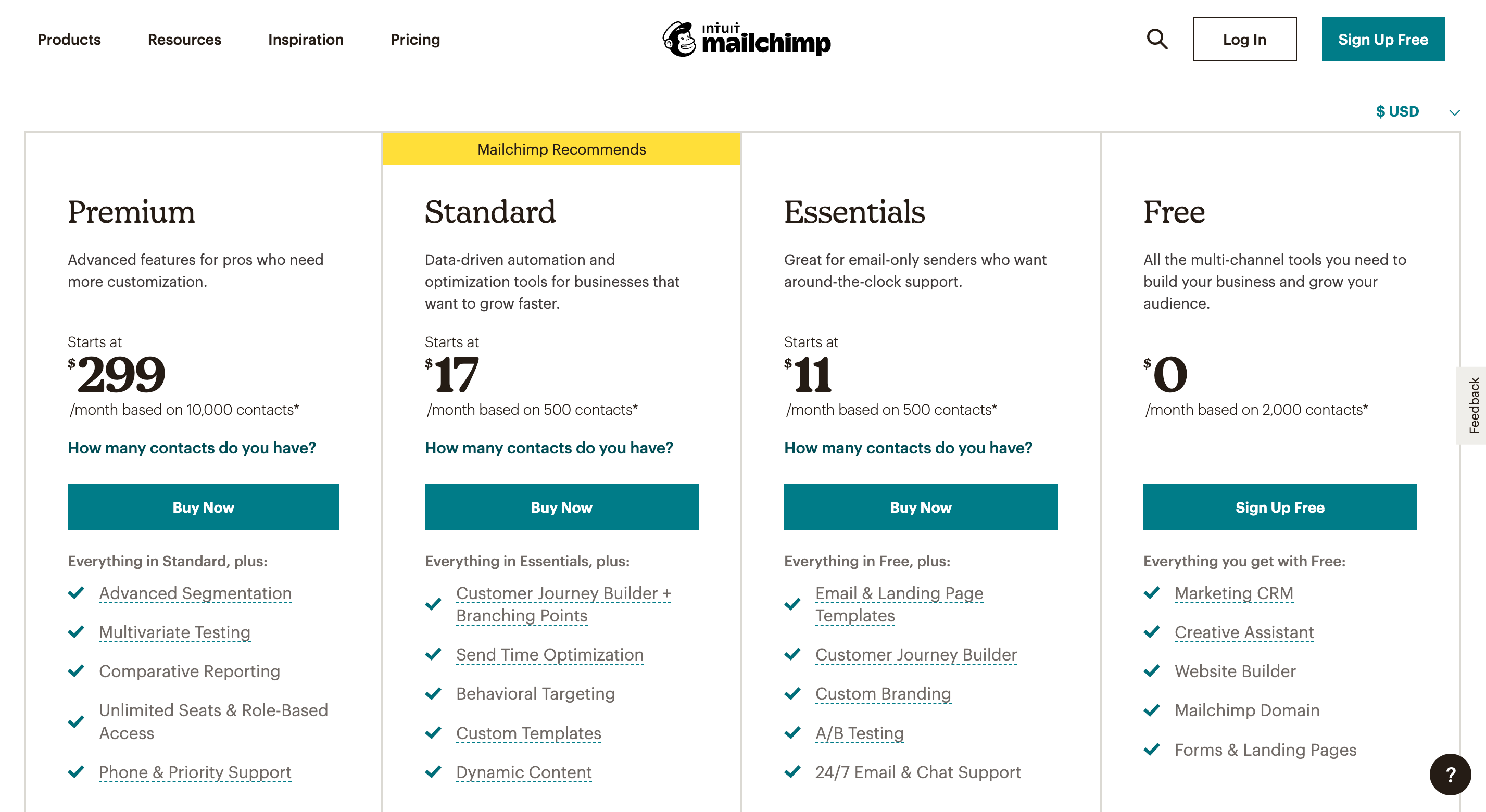
The difference between a pricing model and a pricing strategy
Now we've looked at a range of SaaS pricing models, let's examine the difference between a pricing model and a pricing strategy.
While your pricing model is the foundation of your SaaS business, your pricing strategy exists to help you achieve various objectives in your quest for growth. These objectives might include tackling a new market or developing a different customer base. To achieve these objectives, you'll need to set certain milestones along the journey.
Choosing the right pricing strategy for your business reflects not only your product and its associated production costs but also how your current and potential customers perceive the value of your product.
To illustrate what we mean, let's examine three popular examples of pricing strategies.
1. Volume discount pricing strategy
With the volume discount pricing strategy, you reward customers who buy more of your product or service by giving them a discount. They receive a bigger discount the more they purchase.
The benefits of volume discount pricing include encouraging your customers to buy more and increasing your competitive value, while also appealing to a wide audience. Everyone loves a bargain, right?
Volume discount pricing is a particularly good fit for B2B SaaS, where businesses typically have the capacity to purchase in bulk.
Be mindful though, psychology is key to success with volume discount pricing. You should avoid pricing your product too low, as you’ll risk devaluing your brand in the eyes of your customers.
2. Tiered pricing strategy
When using the tiered pricing strategy, you segment the pricing of your offering to suit your different target markets. Optimizing in this way allows you to serve different levels of demand and price points – and appeal to a broader customer base.
For example, you might segment your tiers according to the number of units, offering more discount as the tiers increase. At first glance, this may feel similar to volume discount pricing, but there’s a subtle difference.
The difference comes from defining the unit thresholds, in which the product or service is priced according to its segment. With volume discount pricing, the discount is applied to all units without any segmentation.
Tiered pricing is typically a good fit for software businesses that sell licenses, seats, or similar. Benefits also include appealing to a wide audience, boosting your conversion rates, creating more upselling potential, and focusing on individual target audiences for each segment.
3. Value-based pricing strategy
The value-based pricing strategy is very different from the two we discussed previously. It involves you pricing your product based on how your customers perceive its value.
While value-based pricing is a popular choice in SaaS, you need to plan carefully to make it work properly for your business.
Value-based pricing isn't driven by the features you offer or the quality of your product. Instead, it's influenced by how you frame the value proposition of your product, along with the strength of your brand.
Effective value-based pricing depends on having a clearly defined target audience. Your product must bring them joy or relief – hence justifying the associated costs.
When considering whether value-based pricing is a good fit for your business, you'll need to understand your target audience, understand the wider market, conduct deep competitor research, and consider your unique selling points.
How to choose the right pricing model for your business
To work out which pricing model is right for your business, you need to first think from your customers’ perspectives. That means having a clear set of customer personas already defined. Use these to figure out who your customers are, and how much they're willing to pay.
Your product’s perceived value plays a key role here. It's really the deciding factor in how much your customers are willing to pay.
Here are some other key questions to ask yourself as a SaaS business:
- What’s our current service and how is it distinct from our competitors?
- Who is our main target audience right now and how might this change in the future?
- Which motivating factors are at play in their buying decisions?
- How will customers pay for our services?
- How will we evaluate the performance of whichever pricing model we choose?
If you’re still in the early stages of defining your pricing approach, don’t be afraid to experiment with different SaaS pricing models to discover what works best for you.
How to change your SaaS pricing model
There may come a time when your pricing model no longer fits your business needs. Or perhaps your business has outgrown it. In those situations, it's time for a change. It's important to regularly re-evaluate your pricing approach and make changes, ideally as often as every six months.
In a fast-changing space like SaaS, customer needs, competitor offerings, and technology itself are constantly evolving. Customers switch easily from one product to another. Your pricing approach needs to reflect the speed of these changes. Without a proactive approach to your pricing, you risk missing out on significant revenue.
A recent study of top companies found a 5% increase in price led to a 22% boost in operating profits. Changing up your pricing could be an easy way to boost your bottom line.
What's more, increasing your price can increase your appeal to customers who value your product or service more highly – which is great for your customer lifetime value.
So we understand how important it is to regularly adjust your pricing model. But when exactly should you do so? Here are some key indicators to watch out for:
- When it's been a long time. This one goes without saying – if you haven't changed your prices since you launched, then you’ll probably need to catch up with your competition.
- When customers don't negotiate. If customers happily pay your prices without a murmur, you should probably raise those prices. If customers keep telling you what a great bargain they're getting, even more so.
- When you’ve added new features. If you’ve added new features to your offering, it's time to update the price to reflect that. Otherwise, you risk wasting the time and energy involved in developing those features.
- When you give great ROI. If your offering provides an especially high level of value to your customers, then make sure you price it with that in mind.
Market research is a key factor in deciding how much to increase your prices, so don’t skip this step! 👀
It's critical to avoid hitting existing customers with big price increases. Instead, consider offering legacy rates for a time in recognition of their early adoption, or raising your new rates gradually over time.
Nevertheless, some customers won't be happy with higher prices and may complain. To handle this, make sure you’re well prepared with a clear and honest response to ensure they understand your decision. Communication is key!
You could also try testing new pricing models with a smaller segment of your existing customers, rather than everyone at the same time.
No matter which pricing approach you decide to take, always keep in mind your unique relationship with your customers and be guided by what makes the most sense for them.